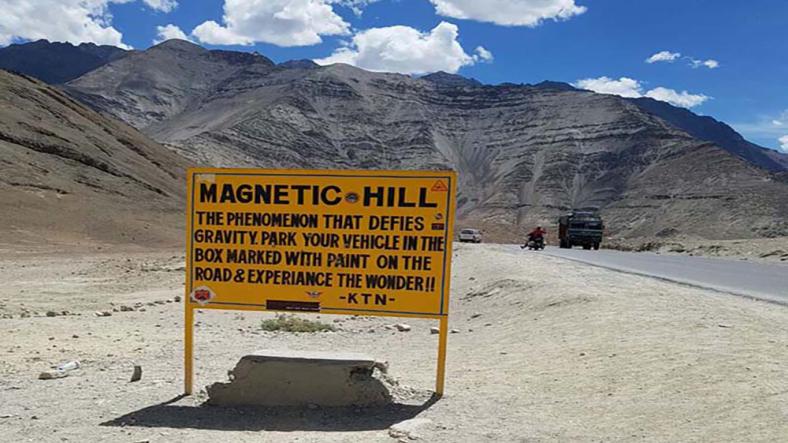High on the Leh–Kargil–Baltal road in Ladakh, at an altitude of about 14,000 feet, lies one of India’s most fascinating geographical puzzles — Magnetic Hill. Known for its mysterious “gravity-defying” behavior, this stretch of road has captivated travelers, scientists, and photographers alike. Vehicles left out of gear appear to move uphill on their own, seemingly pulled by an invisible magnetic force.
For years, visitors have been amazed at how a car, bus, or even a motorcycle left stationary begins to roll upward without any visible push. This strange phenomenon has inspired countless explanations, ranging from magnetic fields and anti-gravity zones to optical illusions and spiritual energy points. But what truly lies behind the mystery of Magnetic Hill?
The Location and the Phenomenon
Magnetic Hill is located about 30 kilometers from Leh, along the Leh–Kargil National Highway. The phenomenon is best observed on a specific stretch of road marked by white paint, where travelers are asked to park their vehicles in neutral at a designated spot.
Once positioned, something strange happens — the vehicle appears to roll uphill, defying gravity. It’s a sight that leaves many in disbelief. Pilots flying over the region have also reported experiencing unusual magnetic interferences, further adding to the mystique of the place.
Scientific Explanations
While folklore attributes this effect to supernatural or magnetic powers, modern science provides more grounded explanations.
1. Optical Illusion (Gravity Hill Effect)
The most widely accepted explanation is that the Magnetic Hill is actually a gravity hill — a type of optical illusion caused by the surrounding landscape.
The arrangement of the hills and the road creates a false visual reference, making a downhill slope appear as an uphill one.
In simple terms, the horizon is distorted by the terrain, and what the eyes perceive as “uphill” is, in reality, a gentle downward slope. The car moves forward due to gravity, but the surroundings trick the observer into believing it’s moving against it.
2. Magnetic Field Theories
Another explanation often cited is the presence of a strong magnetic field in the area, which supposedly pulls metallic objects uphill.
However, repeated scientific studies and geological surveys have found no abnormal magnetic activity strong enough to cause the observed movement. This effectively rules out magnetism as the primary cause, though it remains an interesting local legend.
3. Cognitive Perception and Horizon Cues
Google Ad 1
Our brains rely heavily on the horizon to interpret the slope of a surface. When the horizon line is obscured or tilted — as it often is at Magnetic Hill — our sense of balance and orientation can be fooled.
The visual cues from the mountains and valley trick the brain into misjudging the gradient, reinforcing the illusion that vehicles are rolling uphill.
Local Beliefs and Folklore
For centuries, locals have woven fascinating stories around this mysterious place.
One popular belief is that the hill possesses supernatural powers, pulling worthy souls toward heaven — a concept rooted in Ladakh’s rich Buddhist spiritual traditions.
Some locals also believe the hill was blessed by saints, who gave it divine energy to attract those who have good karma.
These legends, though mystical, reflect how ancient cultures often explained natural phenomena through spiritual or moral frameworks.
Magnetic Hill as a Tourist Attraction
Today, Magnetic Hill is one of Ladakh’s most popular tourist stops, drawing thousands of visitors every year. Travelers often park their vehicles on the marked spot, record the movement on video, and share their experiences online.
It has become a must-see location for bikers on the Leh–Manali route, as well as for adventurers exploring the cold desert landscape of Ladakh.
Nearby attractions include the Sangam (confluence of the Indus and Zanskar rivers), the Hall of Fame War Museum, and the Spituk Monastery — making this stretch a perfect blend of natural wonder, spiritual energy, and historical significance.
The Psychological Fascination Behind It
Part of the allure of Magnetic Hill lies in how it challenges human perception. It’s a rare instance where what we see, what we feel, and what we know don’t align.
This discrepancy triggers curiosity — the same curiosity that drives both travelers and scientists to understand the world beyond appearances.
In a way, the Magnetic Hill reminds us how fragile our sense of reality can be, and how easily the mind can be deceived by visual surroundings. It is not just a natural curiosity but also a lesson in human perception.
Conclusion
The Magnetic Hill of Ladakh continues to mystify and attract people from around the world. While scientific explanations have debunked the myths of magnetism and anti-gravity, the experience remains no less enchanting.
It is, perhaps, this blend of optical illusion, natural beauty, and mythic storytelling that gives Magnetic Hill its enduring charm. Whether you visit as a skeptic, a scientist, or a seeker of mystery, you leave with one undeniable realization — that even in the age of technology, the world still holds places where science meets wonder.
Thanks for reading the article, for more unsolved mysteries related articles read our peoples blog articles.















